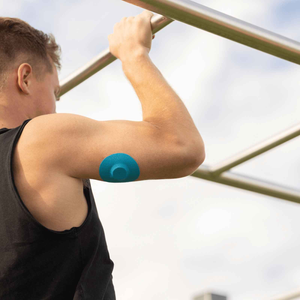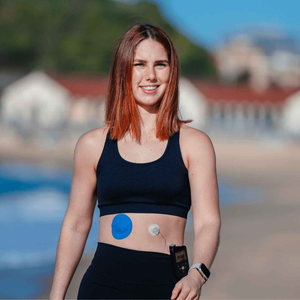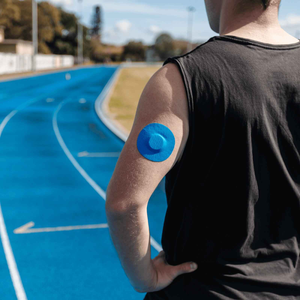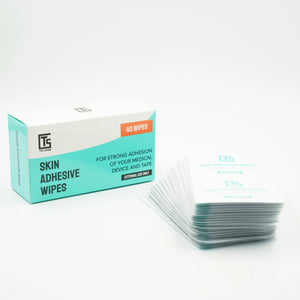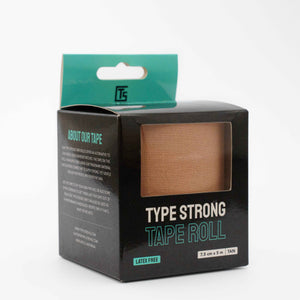If you've ever reached for the nearest roll of medical tape to hold down your CGM, you're not alone. It’s the go-to hack in a pinch. But now that CGM-specific patches are everywhere – in colours, patterns, and all shapes – the question is worth asking:
Do you really need a fancy CGM patch, or does basic medical tape get the job done just as well?
Let’s put both to the test. From real-world wear to skin safety and sensor security, we’ll unpack the pros and cons of medical tape vs CGM patches – so you can decide what’s actually worth sticking with.
What counts as ‘medical tape’ anyway?
Medical tape is a broad term, but in most CGM-user circles, it typically refers to:
- Transparent dressings like Tegaderm
- White paper or cloth tape from the chemist
- Flexible film adhesives like Opsite Flexifix or 3M Medipore
These are designed for general wound care – not diabetes devices specifically. But they’ve been repurposed over time by the T1D community to help sensors stay on longer.
And what exactly is a CGM patch?
A CGM patch is purpose-built to go over or around your device. They’re usually pre-cut to match your sensor shape – whether you're using Dexcom G6, Dexcom G7, Freestyle Libre (1, 2, or 3), Medtronic Guardian, Omnipod, or infusion sets.
The best ones (like our Type Strong CGM patches) are made to:
- Stay put through sweat, showers, and sport
- Last 10+ days without fraying
- Be gentle on sensitive skin
- Look good while doing it
Unlike medical tape, they’re not just functional – they’re wearable.
Round 1: Adhesion strength
CGM patches
✔ Pre-cut for full surface grip
✔ Designed to stretch and flex with movement
✔ Often feature breathable zones or textured fabric to reduce peeling
Verdict: Strong hold without over-stickiness. No trimming or layering needed.
Medical tape
✔ Effective in short bursts
✔ Widely available and cheap
✖ Requires cutting and often layering
✖ Some types peel easily with sweat or friction
Verdict: Good for quick fixes – but tends to lift early unless reinforced or carefully applied. We tested different adhesives head-to-head in our Truth About Patch Claims post – and not all tapes held up equally.
Round 2: Skin sensitivity
CGM patches
✔ Usually made with skin-safe adhesives
✔ Latex-free and hypoallergenic options available
✔ Gentle removal with minimal residue
Verdict: Better suited for long-term wear, especially if you have eczema, allergies, or sensitive skin.
Medical tape
✖ Some options (like Tegaderm) can cause redness or rashes
✖ May trap moisture underneath
✔ Some breathable varieties (like paper tape) are gentler, but not very durable
Verdict: Mixed results. Best to spot-test before committing to multi-day wear.
Important note: Always check for adhesive allergies and consult your doctor if you’ve experienced severe skin reactions – or read our patch irritation guide for early warning signs.
Round 3: Convenience
CGM patches
✔ No scissors needed – just peel and stick
✔ Fits around your specific device
✔ Pre-cut hole keeps sensor uncovered
Verdict: Designed to be fuss-free. Ideal for busy users or caregivers applying for kids.
Medical tape
✖ Can be fiddly – requires cutting to size
✖ May accidentally cover the sensor if not placed carefully
✔ More customisable (good for odd placements)
Verdict: Fine if you’ve got time, tools, and a steady hand – but not the easiest option day-to-day.
Round 4: Longevity
CGM patches
✔ Engineered to last the full 10-day wear cycle
✔ Water-resistant and exercise-friendly
✔ Backed by real-user testing – more in our patch durability test
Verdict: Made to go the distance – and look decent even after a week.
Medical tape
✖ Most only last 1–3 days before curling at the edges
✖ Prone to losing grip with showering or sweating
✖ Often needs reinforcing halfway through
Verdict: Great in a bind. Not built for the long haul.
Round 5: Style and confidence
This one’s subjective – but let’s be honest. Feeling confident in your device setup matters.
CGM patches
✔ Available in patterns, colours, and neutrals
✔ Doesn’t scream “medical tape”
✔ Some users say it even sparks conversations or compliments
Medical tape
✖ Clear or stark white
✖ Often looks clinical or patchwork
✖ Can make users feel more self-conscious, especially in public or social settings
When medical tape does win
There’s no doubt medical tape has its moments. It’s especially handy when:
- You need a quick fix on holiday
- You’ve run out of patches and can’t reorder in time
- You want to double-secure a loose edge
- You're doing a DIY waterproof seal for beach or swim days
And some people genuinely prefer it – especially if they’ve used it for years and know exactly how to apply it with zero fuss.
Universal tips for any device protection
No matter which method you choose, keep these in mind:
- Clean skin first – use alcohol wipes or skin prep to remove oils
- Avoid lotions before applying adhesive (they cause early lifting)
- Give it a warm press – hold the patch down for 30 seconds for best grip
- Rotate sites to give your skin time to breathe and recover
Need help getting the prep right? Read our blog on how to apply your CGM patch the right way for a step-by-step.
So – which is better?
If you're asking medical tape vs CGM patch, here’s the short version:
- Best for short-term or emergencies? Medical tape
- Best for long-term comfort, style, and sensor stability? CGM patches
For most people, a dedicated CGM patch is worth it – especially if you're tired of re-taping mid-wear or dealing with itchy skin.
Want both? Grab our Tape Roll for custom cuts, or build your perfect mix with the CGM Patch Bundle.
Final thoughts
Look, both options have their place. But if you're aiming for hassle-free wear that actually holds up through your week, pre-cut CGM patches win the match.
Explore the full Type Strong patch collection – Dexcom, Libre, Omnipod, Guardian, and more. Designed to stick around, so you don’t have to.
